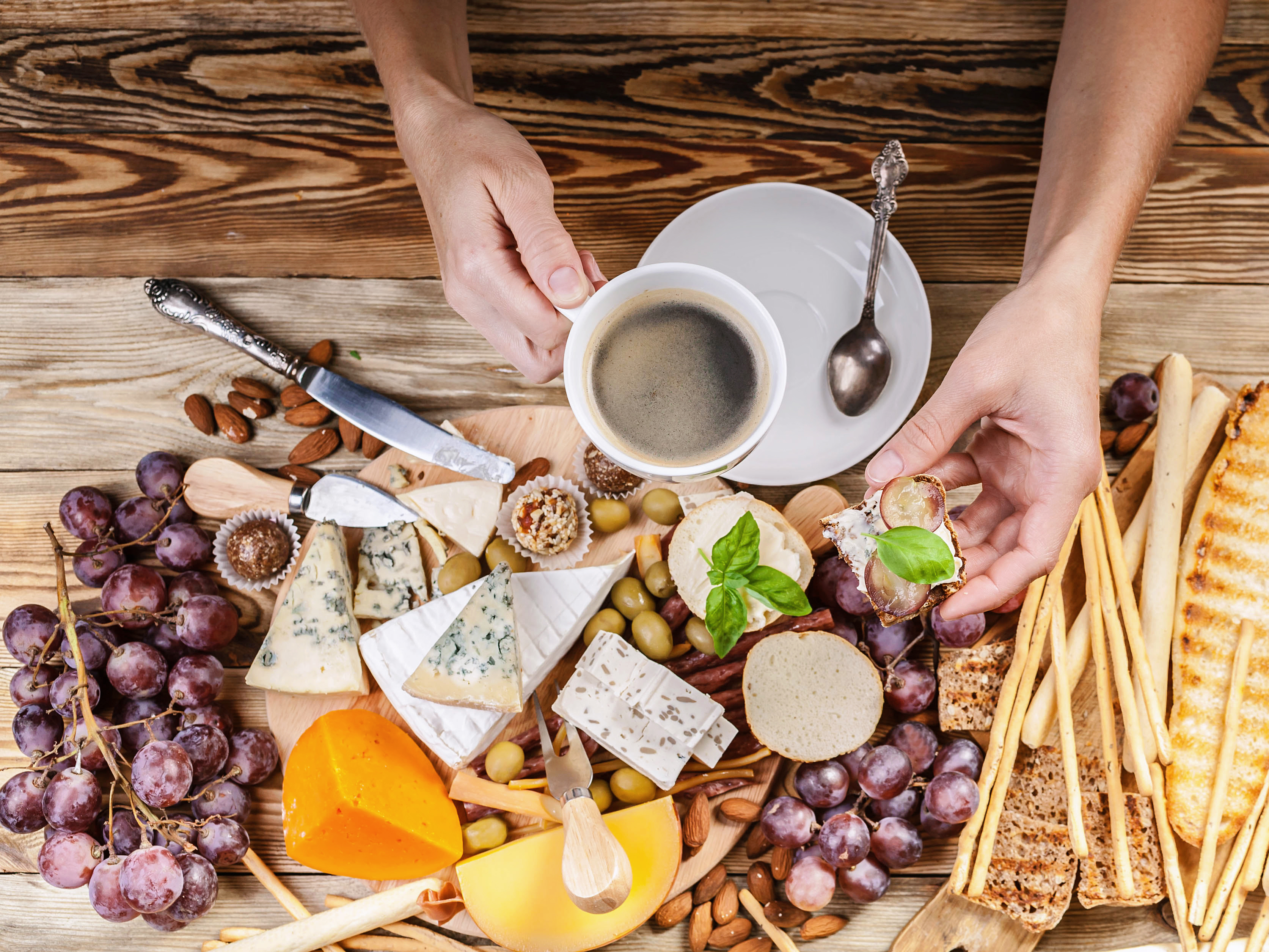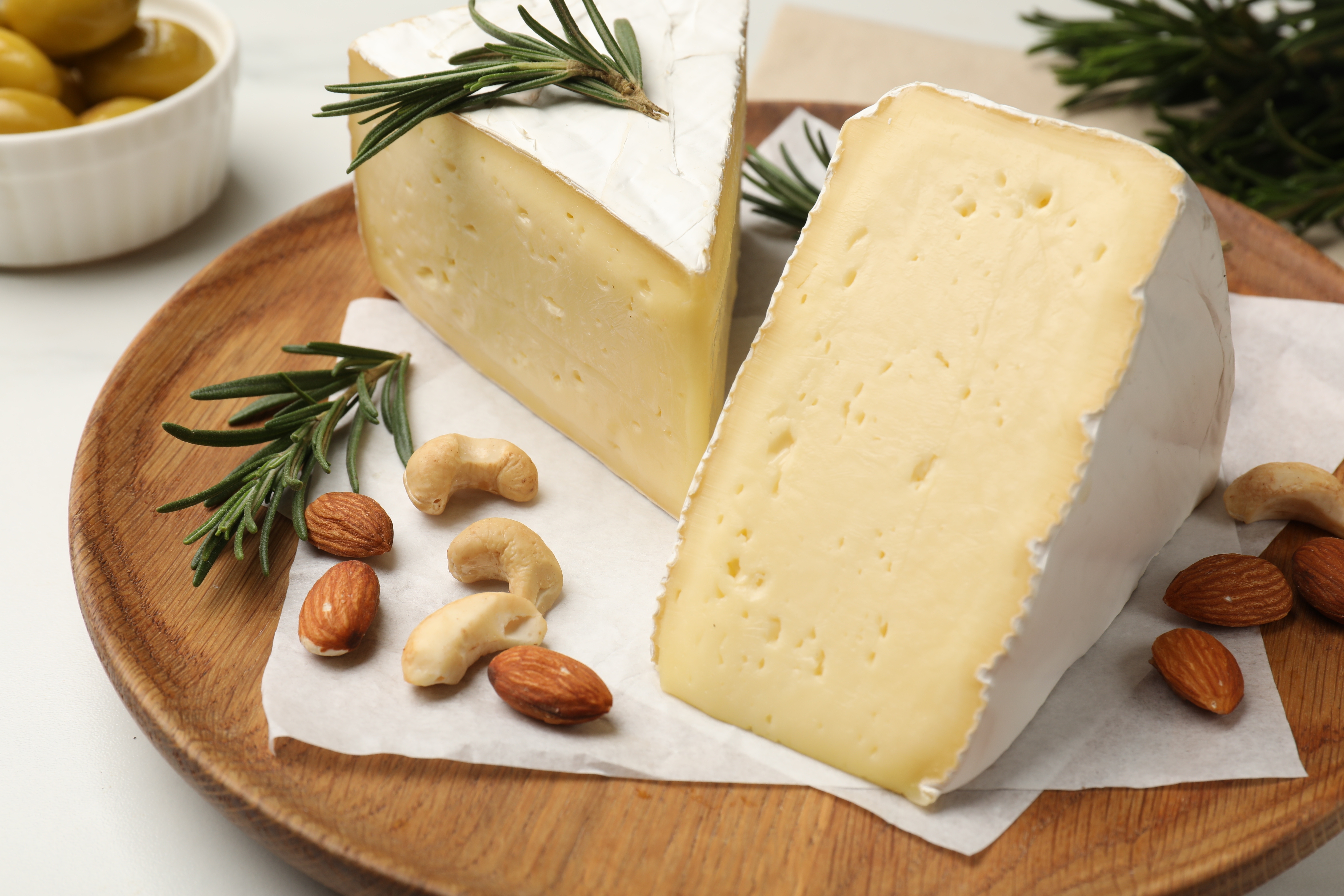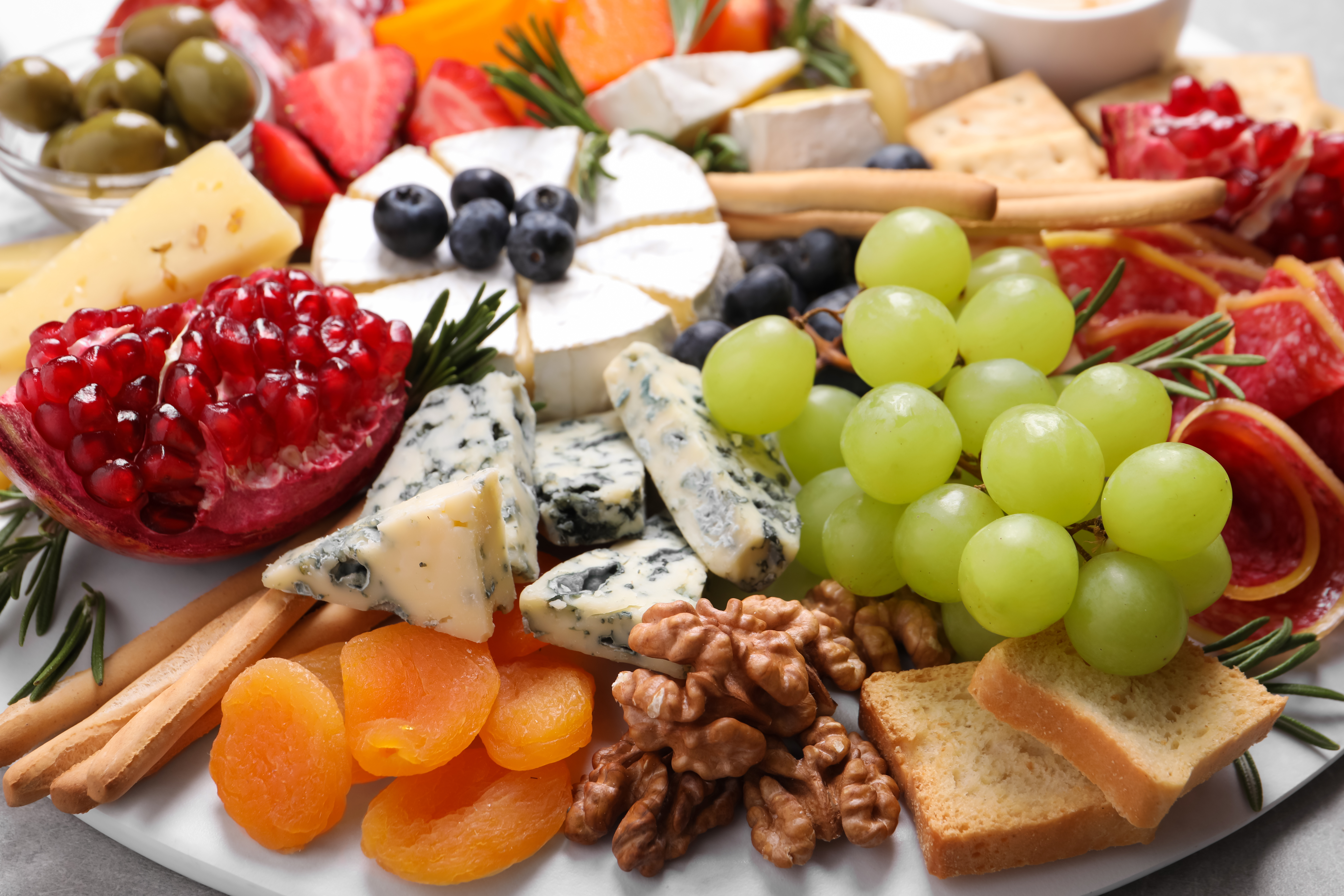Free digital copy
Get Speciality Food magazine delivered to your inbox FREE
Get your free copy
Cheese is a delight all on its own – especially artisanal, handcrafted, farmhouse varieties. But who can resist the joy of pairing a savoury slice of Cheddar, or delicate soft-rinded Brie with something that elevates and enhances it – taking the eating experience to the next level? Not us. We asked the experts about their favourite cheese pairings. There are, of course, a few classics you’ll know, but we also think you’ll be pleasantly surprised by some of their more unusual suggestions. If you’re seeking some new suggestions to pass out to customers at the counter, look no further…
Laura Bradley, Indie Fude
Laura’s all-time favourite cheese pairing is Northern Ireland’s Ballylisk Triple Rose with Dunville’s PX 10-year-old Single Malt, which she says she tried alongside cheesemaker Mark after a visit to the dairy. “We rounded the day off by experimenting with some pairings. These two stunning local delicacies worked to highlight each other wonderfully. And I won’t deny having enjoyed it a number of times since!”
A more off-kilter match, she says, is Coolattin Cheddar with Summerhill Honey and lavender. “Honey is one of my favourite pairings on a cheeseboard, but the addition of an infusion, or some dried petals really amps up the flavour.”
As for the ideal drink for cheese? Red wine and Port are obvious, but how about a can of Modest Beer’s Dreaming of Far Off Lands IPA instead?
Stephen Barney, The Cheesery
“I’m a sucker for White Burgundy and despite my best efforts I’m yet to find a cheese I can’t enjoy with a glass,” Stephen says. “If I had to pick one cheese to enjoy with it, I’d probably go with Epoisses. They’re both made in the same region and the acidity in the wine is the perfect foil for the rich, sticky Epoisses.”
Stephen’s most unique combination is Manchego with anchovy and honey, introduced to him by a Spanish friend. “Yep, we thought it would be horrible too but it’s actually amazing! We also recently made a sauce with Gjetost and double cream - it’s phenomenal with all manner of desserts.”
There’s an honourable mention for Baron Bigod too, which Stephen loves to pair with crusty bread and ice cold pale ale.
Jordan Thomson, Love Cheese
If he was forced to choose, Jordan says his favourite pairing is Gallus with Arbouses Cotes du Rhone. It’s a wintery flavour combination. The cheese is sweet and Marmitey, and it pairs with the gentle spice and warmth from the wine. Lovely.”
Delice de Bourgogne is rather nice, he adds, with Colombian dark chocolate from York Cocoa Works, or Yorkshire Tequila’s Rhubarb Tequila Liqueur, while Flower Marie is exceptional with Koshu Kayagatake – a type of Japanese dry white wine.

Simon Warren, The East Street Deli
“It’s a bit of a classic but Manchego and membrillo is always a winner. If we’re looking for a bit of a treat then truffle honey and Gorgonzola will always hit the spot,” says Simon.
Hot honey has been flying off the deli’s shelves, and Simon recommends trying this with any cheese. “We can’t get enough of it drizzled over some melted Kaltbach on a muffin for a little snack,” he adds.
Drinks-wise, he goes for one of his local producers, the Langham Wine Estate, whose Culver Classic Cuvee is a heavenly match for Baron Bigod.
“We’re also spoilt for choice with some great local brewers and none better than Wimborne neighbours, Eight Arch. We’d pair their award-winning Square Logic Pale Ale with a classic Cheddar like Westcombe or Montgomery’s.”
Eleonore Deneuve, Cheezelo
“I would often recommend having white wine with cheeses as my preference, as red wine tends to overtake the flavours of the cheeses unless you go with hard mature cheese, washed rind ripped soft cheeses or blue cheeses,” Eleonore explains.
She enjoys coffee with cheese. “Particularly an espresso with a semi-soft cheese like Tomme de Savoie, Morbier or a Saint Nectaire … just delicious in the morning. It brings floral notes to my brew. Funny enough, I hate drinking coffee or tea with milk, but love to have a piece or two of cheese on the side!”
For strong, spicy blues such as Gorgonzola Piccante or Picos a French sweet chestnut spread works beautifully. “Similarly, a stout or dark beer with a soft blue such as the German Montagnolo affine or the Irish Crozier Blue is divine, the notes are more focused on the nuttiness and cereals.
“Finally, I’d recommend one of the most popular grilled cheese sandwiches I do at Cheezelo which is the smoked Dorset Red with the chilli jam from Tracklements. The smokiness of the cheese goes very nicely with the sweet and spiciness of the jam.”
Mark Kacary, The Norfolk Deli
Mark is keen to stress he thinks cheese should be enjoyed in its own right or with water, to cleanse the palate, but, equally, he does like to point customers to a few of his favourite local pairings.
He’s a fan of Black Shuck’s Damson Port, and Archangel Distillery’s Cardinalis – a type of fortified sloe wine. “They are Norfolk’s answer to a glass of Port, and if you’re indulging in a rich deep flavoured cheese who wouldn’t like a glass of Port to go with it?”
Something the deli’s customers enjoy is Binham Blue and Seggiano Chestnut Honey with a seasonal IPA from Duration Brewing. “A twist on the traditional Ploughman’s.”
For Mark, it’s a case of keeping things plain and simple. “Crackers will typically be the sourdough crispness of a Peter’s Yard cracker. Having said that I can’t resist the Lingue from Seggiano. Give me a large slice of Baron Bigod, a whole lingue and some Eastgate Larder medlar jelly and I am happy happy happy.”
Chris Hallam, Chorlton Cheesemongers
Brightwell Ash from Norton and Yarrow with a light, dry Bacchus from Brightwell Vineyard as a pairing demonstrates how wonderful it is to match produce from the same terroir, says Chris. The grapes are grown on a similar terrain to where the goats are grazed. “They have been made, unintentionally, for each other,” he muses.
Townsend Farm ciders from Herefordshire go well with most cheeses, Chris adds, particularly British territorials.
“One of my real pleasures is working with local breweries for tasting events and discovering and experimenting with new combos.” Chocolate stout from Seven Bro7hers has proved a hit alongside Blackmount goats’ cheese from Errington Cheese, with Chris declaring the pairing “sensational”. “Together they became a rich, cheesy, chocolatey ‘dessert’, changing both distinct flavours into something completely new.”

Vaik Lucas, The Cheeseworks
A “mind-blowing’ pairing for Vaik is Munster with Liqueurious Ryokucha green tea liqueur.
“The kick from the liqueur is partially absorbed by the richness and sweetness of the Munster and allows the cheese to develop some fantastic fresh, grassy undertones that are not normally part of its profile,” he says.”
Rory Mellis, I J Mellis
You can’t beat the classic meeting of ham and cheese says Rory, who reveals it as one of his top cheese pairings. Outside of that Tunworth, the English take on Camembert, is excellent with chilli oil, he adds. “We like to use Halfway Chilli Oil, a mild, Sichuan-inspired chilli oil made by the team at Halfway Kitchen. The warmth from the oil adds a satisfying kick to the delicate and nutty cheese.”
Gemma Ackroyd, The Cheeseboard
“I do a lot of work with the local wine shop in Harrogate and we put on cheese and wine events. We always try to pair the cheese and wine beforehand, and the best combination with all our customers in agreement is Munster and Gewurztraminer. They’re both from Alsace, both full flavoured, the Munster sticky and stinky and the wine sweet which, when put together, is a taste sensation!
“Although not that unusual to the North, I’m originally from London, so when someone recommended fruit cake with Wensleydale cheese I wondered what on earth they were thinking! Now I must be a true Yorkshire woman, as I completely agree and think it’s a delicious combination.”
As for drinks? “A lot of people think that red wine with cheese is the classic pairing but actually I love a glass of white Chardonnay with a soft gooey brie. The acidity of the wine cuts right through the fattiness of the cheese and it marries beautifully.”
Avril Molloy, La Rousse Foods
Avril likes to keep it nice and simple with cheese. Hard cow’s milk cheeses such as Cheddar are great with sparkling apple juice, she says. And match soft goats’ cheese with French Sauvignon Blanc.
Heather Copley, Farmer Copley’s
Pitchfork Cheddar with the farm’s own pumpkin bread is a real treat for Heather. It’s more of a sticky, sweet cake, she says. “If you imagine sweet roasted pumpkin and gourds with autumn spices and tangy Cheddar – delicious.”
Another pairing she enjoys is good quality mozzarella with sun-ripened, room temperature tomatoes, basil and the best balsamic.
Heather likes to pair cheese with Favola Prosecco, Moutard, or Real’s Royal Flush Sparkling Tea.

Michael Thompson, Mike’s Fancy Cheese
Young Buck with a mince pie from Manmade Bakery is one of Mike’s dream cheese pairings. “Christmas is a crazy time for cheese shops so after a hectic week, settling down with this washed down with some Mescan (a great Irish Belgian-style brewery) special reserve is such a treat.”
Kimchi and sauerkraut is another combination Mike encourages cheese lovers to try. “Also, you can’t beat a good fruit jelly and we are spoilt with apples in Northern Ireland. We have a local chef, Karen Bell, who makes us apple cheeses spiked with different hedgerow fruits each autumn for the Christmas period.”
Jessica Honey, Curd & Cure
Pink pickled onions with Cheddar compliment one another well, says Jessica, who also like to serve up frozen red grapes with the cheese. “When frozen, they turn into mini sorbets, which pair beautifully with cheese as well as providing the perfect palate cleanser.”
Another of Jessica’s tips is Chapel Down Bacchus with soft, lactic cheeses.
Daniel Williams, Godfrey C Williams & Son
Appleby’s White Cheshire and fruit cake is a Williams family wedding favourite, Daniel exclaims.
Going off tangent, he also recommends trying a creamy blue cheese with milk chocolate-covered pretzels. “The sweet/salty combo of the pretzel matches the creaminess of the blue.”
As for drinks. Daniel is partial to Artelium Blanc de Blancs with Sharpham’s Elmhirst. “This Supreme Champion from Sussex has a vibrant mousse and lemon posset palate that combines beautifully with the triple-cream freshness of the Devon cheese.”
Julie Oxley-Hoyle, Lewis & Cooper
Julie has a thing for dark chocolate digestive biscuits with blue cheese, saying Perl Las is a good place to start.
Being a Yorkshire resident, fruit cake and Wensleydale cheese is another cracking pairing she’ll always recommend – not limiting the match to the traditional Christmas period.
Any fruit cake works, “the richer the better”, but her Wensleydale of choice is Old Roan (Yoredale), made by Ben and Sam Spence.
Taking her tastebuds to sunnier climes, Julie likes a chilled Sherry such as Barbadillo Manzilla Pasada alongside aged Manchego.
Andy Swinscoe, The Courtyard Dairy
Andy is a purist, but does concede that fruit cake with Wensleydale, or Eccles cake with Lancashire cheese are “hard to beat as a nice snack”. Poached rhubarb with Yorkshire Pecorino is worth a try as well, he says. “I first tried it at Skosh restaurant in York and was converted.”
Keeved cider is excellent with territorials too, he enthuses. “Particularly traditionally keeved perry – it is very underrated. Look out for Oliver’s. Trust me, you have to try it to believe it!”
Gemma Williams, The Little Cheesemonger
Gorgonzola on top of Miller’s Plum & Date Toast is “simple yet fabulous”, says Gemma, whose other top cheese pairings are Jonathan Crump’s Single Gloucester with blood orange marmalade, and Pedro Ximenez Sherry with strong cheeses.
Stephen Fleming, George & Joseph
Fruit cake with Kirkham’s Lancashire floats Stephen’s boat. “I also love Single Variety Co’s Fireflame Chilli Jam with Baron Bigod – the sweetness of the jam counterbalances so well with the bitter notes of the cheese, and there’s just enough heat to not overwhelm everything.”
If you’re daring to be different he suggests cheese and coffee. “We once did a pairing event with a local coffee shop, and we loved pairing Reypenaer VSOP Gouda with espresso. The caramel notes of the cheese really sat well with the coffee.”
Svetlana Kukharchuk, The Cheese Lady
Svetlana has some sophisticated pairings to suggest. Her top pick is a luscious Delice des Cremiers ... with Champagne, of course. Otherwise she’s very happy to tuck into burrata drizzled with chestnut honey on date and walnut bread.
Julie Harbutt, cheese expert
Julie, naturally, has a lot to say on the topic of cheese pairings, with almost 40 tips for cheese fans, going through the spectrum of textures and types.
To start, she recommends putting fresh cheeses with light, delicate, crisp white or fruity rose wines.
Soft, wrinkled cheeses like Crottin and St Maure prefer dry, white wines with acidity, like Sauvignon Blanc. “The older they are the more intense the flavour, so they’ll need a more spicy, forthright wine like the young, fruity reds of the Loire or the soft-natured Merlot.” Or off a Pilsner, to bring out the peppery, spicy nature of the cheese. Julie says ciabatta, not crackers, work best with these cheeses, which are also good bedfellows with tapenade and sundried tomatoes.
Working up to the soft, mould-rinded cheeses such as Brie and Camembert, Julie says the young, slightly sharp, salty varieties prefer sweet, late harvest wines, while “double cream cheeses need a fruitier wine with a good acidity to cut through the extra fat like rosé, fruity whites or Champagne. The more meaty, savoury classic Brie- style cheeses prefer a full-bodied, oaked white or soft tannin red like Pinot Noir, and the French love a dry cider.”
Squish these onto sourdough or brioche, or within a croissant “alongside plum chutneys, fig syrup, or one of those balls of pressed figs in chestnut leaves”.
Pungent, meaty, washed rind cheeses demand the complex but mellow character of a Pinot Noir, a Cabernet-Merlot blend, something from the Alsace, fruity, assertive ciders, or a big, hoppy IPA. Their character can be balanced, Julie says, with dried figs, Muscatel raisins or caper berries.
Almost any wine will match with harder cheeses such as Cheddar or Pecorino, but Julie’s general rule is the stronger and darker the cheese, the bigger and darker the wine. “White wine loses itself to a strong, mature cheese; the cheese’s butterfat coats the palate, blocking the wine’s flavour. Fortified wines like Fino Sherry, vintage Port, Marsala or an old Madeira can be truly magnificent with the very old, very hard brittle cheeses.”
Younger, hard English cheeses are happy with cider or beer (especially a big British bitter), while hard ewe’s milk cheeses go hand-in-hand with the soft notes of a Shiraz, Sangiovese or lighter vintage Port.
“These are bold, full-bodied cheeses so they relish a partnership with similar punch like chutneys, dried nuts, cornichons or sweet chilli jam, accompanied by a good solid cracker like an oatcake.”
Julie has several thoughts on the best pairings for blue cheese. “European blues are wet, sticky and wrapped in tinfoil, and their salty tang and old socks aroma holds strong attraction for the sweet and luscious dessert wines like Muscat, Late Harvest Gewurztraminer, Montbazilliac and some of the less sweet pudding wines of the New World, creating a marvellous marriage of opposites,” she says. “The right match will also emphasise the hidden sweetness of the milk, particularly Roquefort.
“English blues are typically dry, crusty and wrapped in parchment like Stilton or Shropshire Blue, with a rich, buttery texture that loves the sweet caramel notes of a tawny Port.”
For something different, Julie says to try Spanish Albarino, very appley cider, or a chocolatey Porter. To eat? Those fabulous pressed fig and almond cakes typical of Portugal and Spain.
Morgan McGlynn, Morgan Cheeses
Morgan’s no stranger to hosting cheese pairing events and, like Julie, has a lot to talk about here. Her best fresh cheese pairing is Brie de Meaux with fresh British strawberries, with a Pinot Blanc or young Chardonnay alongside. “For soft and bloomy cheeses I would go for dry, traditional-method sparkling wines such as a Brut Champagne. Also a light-bodied Chardonnay, Sancerre and a young dry Riesling.”
Whereas hard cheeses such as Gouda, Cheddar and Comte are most often served by Morgan with chilli jam or quince paste and a dry white wine with a touch of oak. “Like Pinot Gris or Rioja or, for a red option, a good Côtes du Rhône or Chianti.”
Morgan’s favourite way to eat blue cheese is with “gorgeous ripe gritty pears, truffle honey or with strong dark chocolate”, and a Sauternes, Riesling Beerenauslese or Vin Santo.
And for something extraordinary, she says you have to try Choco 21 cheese – a blue covered in chocolate – with ripe cherries. “This one is an upgrade on any cheeseboard, it’s like a dessert and so delicious. The best, and most fun, way to pair cheeses is to experiment and try all sorts as you may find a winning combination.”